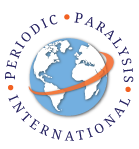Physicians & Patients Library
Welcome to the Physician & Patient Library
One of the core missions of Periodic Paralysis International is to serve as a trusted documentation
resource for all aspects of Periodic Paralysis. This library brings together materials created for both
patients and health care providers, along with carefully selected links to outside resources.
This is an ongoing project, designed to grow and evolve for many years to come. While we are just
getting started, new material will continue to be added on a regular basis. Our goal is to provide a
comprehensive, reliable, and accessible source of information to support both medical professionals
and the PP community.
Disclaimer
The resources in this library are provided for informational purposes only. Periodic Paralysis
International does not guarantee the accuracy or completeness of this material. Content should not
be used as a substitute for professional medical advice, diagnosis, or treatment. Always consult your
physician or qualified health care provider regarding any medical questions or concerns.
Pregnancy and Birth in the Periodic Paralysis Patient
The Use of Bactrim in the Periodic Paralyses
Sleep Complaints in Periodic Paralysis
Physician’s Reading Room
New Findings Suggest Genetics Behind Drug Response
Physician’s Information: Local Anaesthesia
Malignant Hyperthermia
Anaesthesia and peri-operative care in the primary Periodic Paralysis Disorders
Measuring quality of life impairment in periodic paralyses
How to Determine What Triggers Attacks of Periodic Paralysis
Anesthesia and Peri-Operative Care in the primary Periodic Paralysis Disorders. Part 1: A Review of the Literature
Anesthesia and Peri-Operative Care in the primary Periodic Paralysis Disorders. PART 2: Practical Guidelines
Anesthesia for the PEDIATRIC Patient with Hypokalemic Periodic Paralysis
Anesthesia for the ADULT Patient with Hypokalemic Periodic Paralysis
Anesthesia and Peri-Operative Care in the primary Periodic Paralysis Disorders. Part 1: A Review of the Literature
Anesthesia and Peri-Operative Care in the primary Periodic Paralysis Disorders. PART 2: Practical Guidelines
Practical aspects in the
management of hypokalemic periodic paralysis
Management considerations in hypokalemic periodic paralysis include accurate diagnosis, potassium dosage for acute attacks, choice of diuretic for prophylaxis, identification of triggers, creating a safe physical environment, peri-operative measures, and issues in pregnancy. A positive genetic test in the context of symptoms is the gold standard for diagnosis. Potassium chloride is the favored potassium salt given at 0.5-1.0 mEq/kg for acute attacks. The oral route is favored, but if necessary, a mannitol solvent can be used for intravenous administration. Avoidance of or potassium prophylaxis for common triggers, such as rest after exercise, high carbohydrate meals, and sodium, can prevent attacks. Chronically, acetazolamide, dichlorphenamide, or potassium-sparing diuretics decrease attack frequency and severity but are of little value acutely. Potassium, water, and a telephone should always be at a patient’s bedside, regardless of the presence of weakness. Perioperatively, the patient’s clinical status should be checked frequently. Firm data on the management of periodic paralysis during pregnancy is lacking. Patient support can be found at http://www.periodicparalysis.org.
Characterization of hyperkalemic periodic paralysis: a survey of genetically diagnosed individuals
This exploratory study aims to create an evidence-based comprehensive characterization of hyperkalemic periodic paralysis (hyperPP). HyperPP is a rare genetic disorder that causes episodes of flaccid paralysis. Disease descriptions in the literature are based upon isolated clinical encounters and case reports. We describe the experience of a large cohort of genetically diagnosed individuals with hyperPP. We surveyed genetically characterized individuals age 18 and over to assess disease comorbidities, diagnostic testing, management, and quality of life issues relevant to hyperPP. Myotonia was reported by 55.8 % of subjects and paramyotonia by 45.3 %. There is a relative risk of 3.6 (p < 0.0001) for thyroid dysfunction compared to the general population. Twenty-five percent of subjects experienced their sentinel attack in the second decade of life. It took an average of 19.4 years and visits to four physicians to arrive at the diagnosis of hyperPP. In addition to limbs and hands being affected during attacks, 26.1 % of subjects reported their breathing musculature was affected and 62.0 % reported their facial muscles were affected. There was a lifelong trend of increasing attack frequency, which was particularly common during childhood and adolescence. Approximately one-third of individuals experienced progressive myopathy. Permanent muscle weakness was evident and worsened during childhood and after age 40. Those with no chronic treatment regimen have a RR of 2.3 for inadequate disease control compared to those taking long-term medications. This study revealed a multitude of heretofore unidentified characteristics of hyperPP, in addition to providing a different perspective on some previously held notions regarding the condition.


